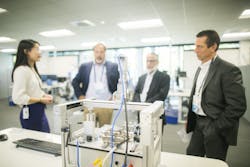21st Century Manufacturing Intersects Life Sciences at the Festo Technology Engineering Center
Festo, one of the world’s leading manufacturers of pneumatic and electromechanical systems, recently dedicated the company’s new Technology Engineering Center (TEC), located just north of Boston. The TEC is the company’s first engineering center in the United States devoted to the life sciences.
The choice of the United States for this engineering center was based on this country’s leadership in the global life sciences industry. Locating the researchers and developers in greater Boston was due to the proximity of the area’s research institutions such as MIT, Harvard, and Brown, the confluence of laboratory equipment manufacturers, and the pool of qualified technologists.
The goal of TEC Boston is two-fold:
·Pioneer the development of new high speed, high accuracy fluid handling products based on pneumatic principles
·Work with individual customers on automated motion and fluid handling solutions that help bring their laboratory equipment to market faster and at less cost.
Increasing the speed and accuracy of screening and sequencing is essential to lowering health care costs
In an automated screening or sequencing machine, small amounts of fluid-based samples are dispensed into shallow wells on what are called in the life sciences microplates. As the number of wells on each microplate has climbed, the amount of fluid in the sample has decreased. This means that the physics of dispensing small sample amounts at ever higher rates has neared its limits.
The Festo team is developing a new approach to fluid dispensing that is based on fast acting valves and pneumatic pressure in addition to using micro-pumping technology. Utilizing pneumatic control and the latest Festo motion technology can, at a minimum, lower subsystem costs and, at a maximum, begin to exceed current speed, volume, and accuracy norms.
Speed and accuracy goals for fluid dispensing
The initial target for the first new Festo products has been the development of pneumatic systems to fill 384 well plates within 15 seconds, handling fluid volumes between 500 nanoliters to five microliters. Current systems achieve a coefficient of variation (CV), also known as relative standard deviation (RSD), of less than two percent in a wide variety of applications. A benefit of working with Festo is that equipment manufacturers have a single supplier for an integrated motion and fluid dispensing system.
“For the past year, we’ve been equipping the engineering center in Billerica and hiring and training our team,” said Dr. Frank Jacob, Head of the Project Unit Medical Devices & Laboratory Automation at Festo. “Festo is combining its latest motion automation used in the manufacturing and processing industries with expertise in pneumatics to create new systems that contribute to lower costs by increasing laboratory output. This technology also enables Festo customers to improve time to market and lower engineering expenditures.”
Festo has been developing components and system solutions for equipment manufacturers specializing in the automation of laboratory processes and the manufacture of medical devices since 2004. Due to double-digit growth, this business area was made a separate division at Festo in 2015. Wolfgang Trautwein, Manager Business Development LifeTech at Festo, will spend extended periods of time in the U.S. during 2019, acting as the company’s ambassador to universities and equipment manufacturers. For more information on the services of TEC Boston, email [email protected] and visit Festo Life Sciences on the web.

